LPSY 309: Moral Development, Attachment, and Identity Development
VerifiedAdded on 2023/03/21
|7
|1750
|55
Essay
AI Summary
This essay delves into the intricate relationship between moral development and attachment theory across the lifespan, examining how early childhood experiences shape an individual's sense of self and influence their social-emotional, moral, and identity development. It begins by defining attachment as a deep emotional bond, highlighting the significance of early relationships, particularly with parents, in fostering secure attachments. The essay explores various attachment styles—secure, anxious/ambivalent, anxious-avoidant, and fearful-avoidant—and their impact on an individual's behavior, relationships, and overall well-being. It further analyzes the role of peer relationships, social media, and other factors that influence these attachments. The paper also discusses how factors such as medical conditions, emotional regulation, and temperament can influence attachment styles. Finally, the essay emphasizes the importance of understanding attachment theory for positive development, and highlights the need for secure attachments to ensure a person's confidence and happiness.
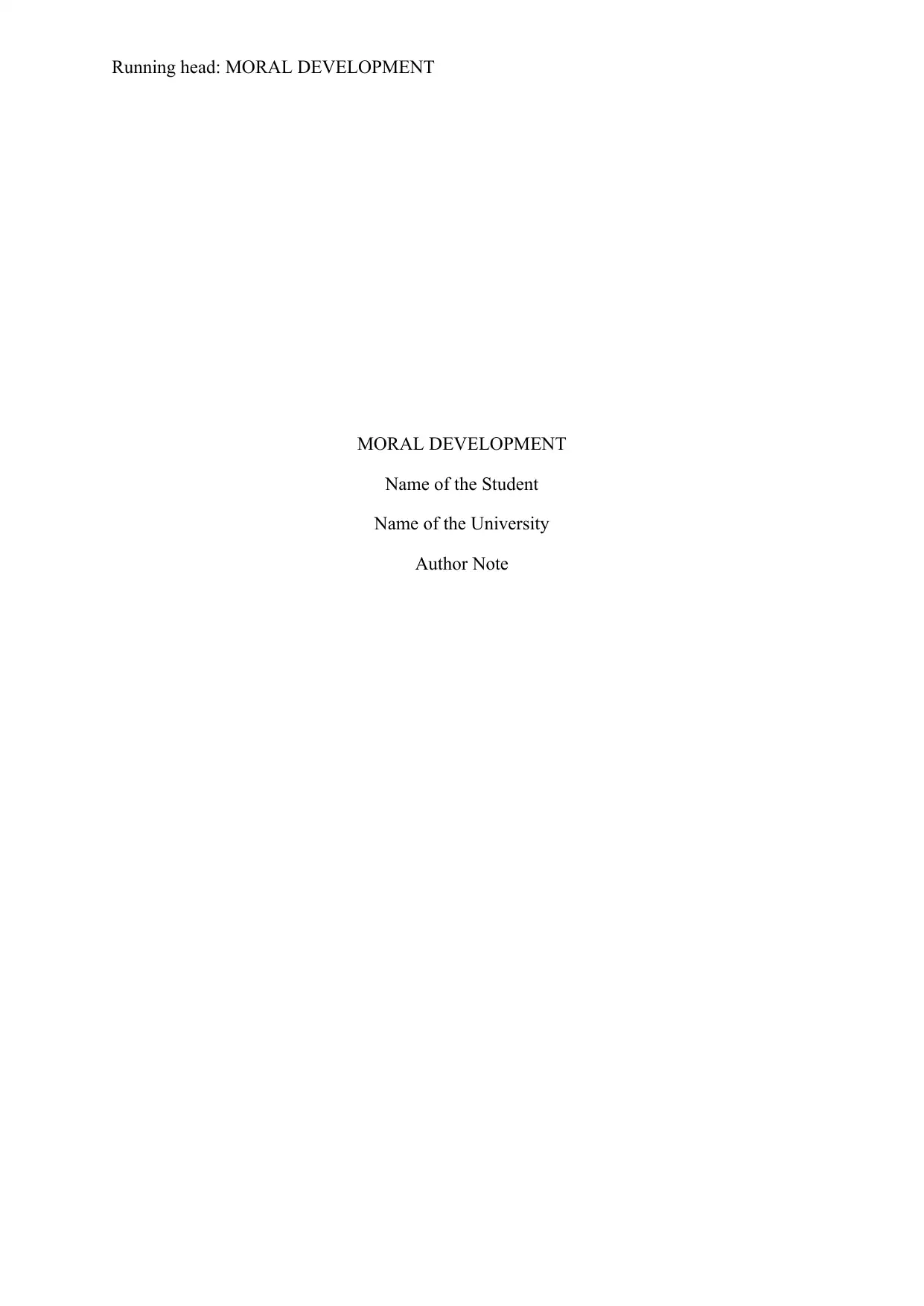
Running head: MORAL DEVELOPMENT
MORAL DEVELOPMENT
Name of the Student
Name of the University
Author Note
MORAL DEVELOPMENT
Name of the Student
Name of the University
Author Note
Paraphrase This Document
Need a fresh take? Get an instant paraphrase of this document with our AI Paraphraser
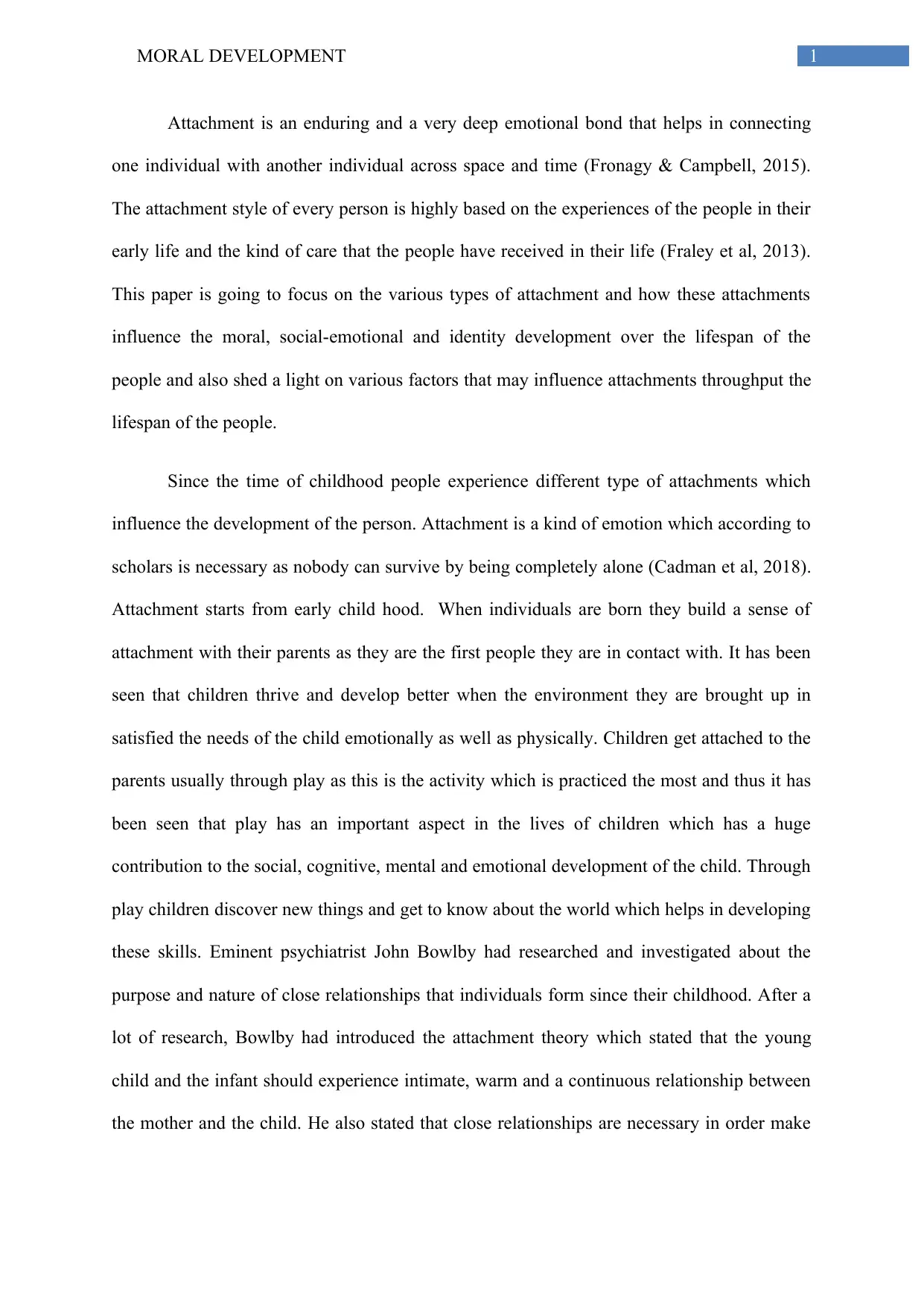
1MORAL DEVELOPMENT
Attachment is an enduring and a very deep emotional bond that helps in connecting
one individual with another individual across space and time (Fronagy & Campbell, 2015).
The attachment style of every person is highly based on the experiences of the people in their
early life and the kind of care that the people have received in their life (Fraley et al, 2013).
This paper is going to focus on the various types of attachment and how these attachments
influence the moral, social-emotional and identity development over the lifespan of the
people and also shed a light on various factors that may influence attachments throughput the
lifespan of the people.
Since the time of childhood people experience different type of attachments which
influence the development of the person. Attachment is a kind of emotion which according to
scholars is necessary as nobody can survive by being completely alone (Cadman et al, 2018).
Attachment starts from early child hood. When individuals are born they build a sense of
attachment with their parents as they are the first people they are in contact with. It has been
seen that children thrive and develop better when the environment they are brought up in
satisfied the needs of the child emotionally as well as physically. Children get attached to the
parents usually through play as this is the activity which is practiced the most and thus it has
been seen that play has an important aspect in the lives of children which has a huge
contribution to the social, cognitive, mental and emotional development of the child. Through
play children discover new things and get to know about the world which helps in developing
these skills. Eminent psychiatrist John Bowlby had researched and investigated about the
purpose and nature of close relationships that individuals form since their childhood. After a
lot of research, Bowlby had introduced the attachment theory which stated that the young
child and the infant should experience intimate, warm and a continuous relationship between
the mother and the child. He also stated that close relationships are necessary in order make
Attachment is an enduring and a very deep emotional bond that helps in connecting
one individual with another individual across space and time (Fronagy & Campbell, 2015).
The attachment style of every person is highly based on the experiences of the people in their
early life and the kind of care that the people have received in their life (Fraley et al, 2013).
This paper is going to focus on the various types of attachment and how these attachments
influence the moral, social-emotional and identity development over the lifespan of the
people and also shed a light on various factors that may influence attachments throughput the
lifespan of the people.
Since the time of childhood people experience different type of attachments which
influence the development of the person. Attachment is a kind of emotion which according to
scholars is necessary as nobody can survive by being completely alone (Cadman et al, 2018).
Attachment starts from early child hood. When individuals are born they build a sense of
attachment with their parents as they are the first people they are in contact with. It has been
seen that children thrive and develop better when the environment they are brought up in
satisfied the needs of the child emotionally as well as physically. Children get attached to the
parents usually through play as this is the activity which is practiced the most and thus it has
been seen that play has an important aspect in the lives of children which has a huge
contribution to the social, cognitive, mental and emotional development of the child. Through
play children discover new things and get to know about the world which helps in developing
these skills. Eminent psychiatrist John Bowlby had researched and investigated about the
purpose and nature of close relationships that individuals form since their childhood. After a
lot of research, Bowlby had introduced the attachment theory which stated that the young
child and the infant should experience intimate, warm and a continuous relationship between
the mother and the child. He also stated that close relationships are necessary in order make
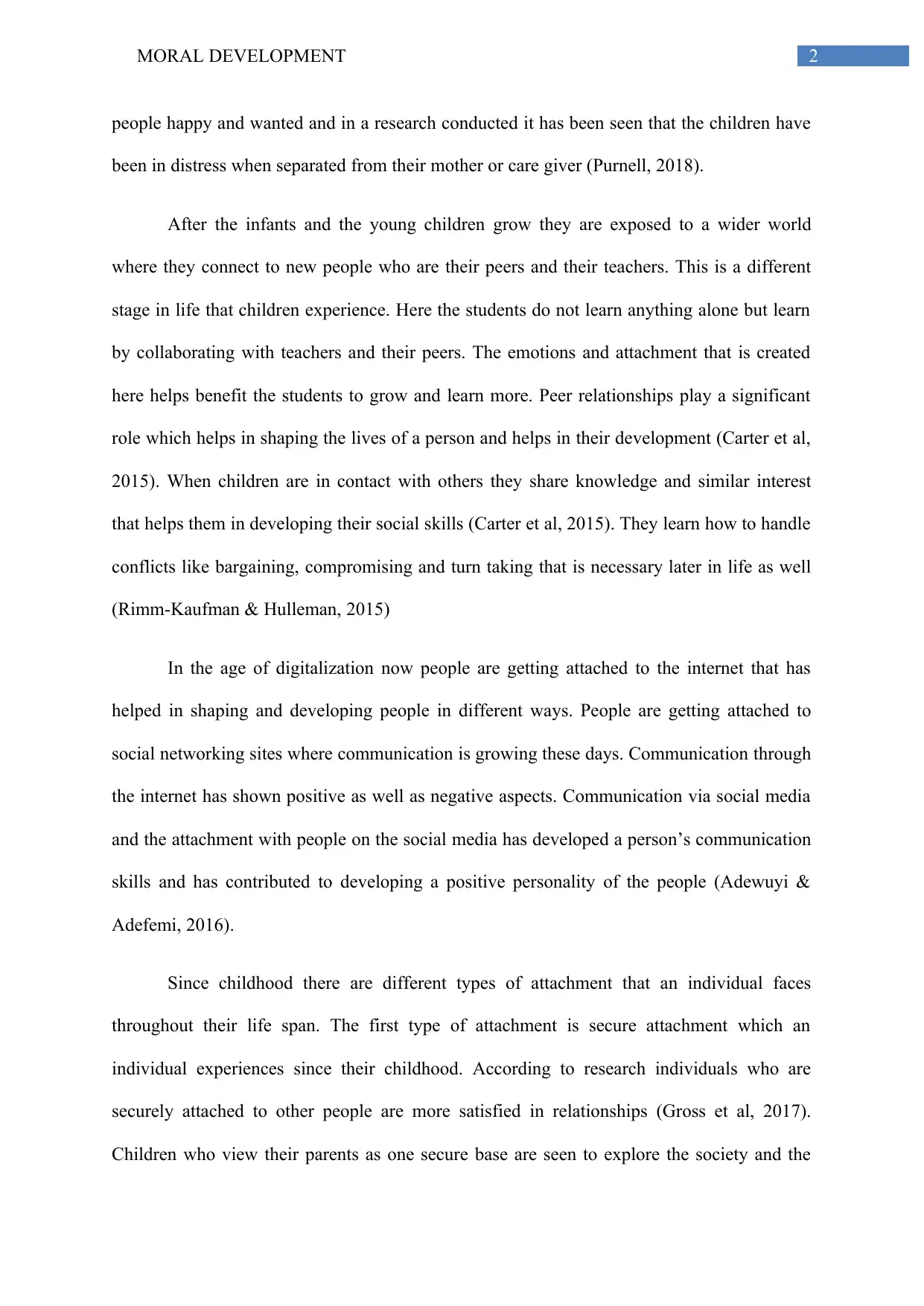
2MORAL DEVELOPMENT
people happy and wanted and in a research conducted it has been seen that the children have
been in distress when separated from their mother or care giver (Purnell, 2018).
After the infants and the young children grow they are exposed to a wider world
where they connect to new people who are their peers and their teachers. This is a different
stage in life that children experience. Here the students do not learn anything alone but learn
by collaborating with teachers and their peers. The emotions and attachment that is created
here helps benefit the students to grow and learn more. Peer relationships play a significant
role which helps in shaping the lives of a person and helps in their development (Carter et al,
2015). When children are in contact with others they share knowledge and similar interest
that helps them in developing their social skills (Carter et al, 2015). They learn how to handle
conflicts like bargaining, compromising and turn taking that is necessary later in life as well
(Rimm-Kaufman & Hulleman, 2015)
In the age of digitalization now people are getting attached to the internet that has
helped in shaping and developing people in different ways. People are getting attached to
social networking sites where communication is growing these days. Communication through
the internet has shown positive as well as negative aspects. Communication via social media
and the attachment with people on the social media has developed a person’s communication
skills and has contributed to developing a positive personality of the people (Adewuyi &
Adefemi, 2016).
Since childhood there are different types of attachment that an individual faces
throughout their life span. The first type of attachment is secure attachment which an
individual experiences since their childhood. According to research individuals who are
securely attached to other people are more satisfied in relationships (Gross et al, 2017).
Children who view their parents as one secure base are seen to explore the society and the
people happy and wanted and in a research conducted it has been seen that the children have
been in distress when separated from their mother or care giver (Purnell, 2018).
After the infants and the young children grow they are exposed to a wider world
where they connect to new people who are their peers and their teachers. This is a different
stage in life that children experience. Here the students do not learn anything alone but learn
by collaborating with teachers and their peers. The emotions and attachment that is created
here helps benefit the students to grow and learn more. Peer relationships play a significant
role which helps in shaping the lives of a person and helps in their development (Carter et al,
2015). When children are in contact with others they share knowledge and similar interest
that helps them in developing their social skills (Carter et al, 2015). They learn how to handle
conflicts like bargaining, compromising and turn taking that is necessary later in life as well
(Rimm-Kaufman & Hulleman, 2015)
In the age of digitalization now people are getting attached to the internet that has
helped in shaping and developing people in different ways. People are getting attached to
social networking sites where communication is growing these days. Communication through
the internet has shown positive as well as negative aspects. Communication via social media
and the attachment with people on the social media has developed a person’s communication
skills and has contributed to developing a positive personality of the people (Adewuyi &
Adefemi, 2016).
Since childhood there are different types of attachment that an individual faces
throughout their life span. The first type of attachment is secure attachment which an
individual experiences since their childhood. According to research individuals who are
securely attached to other people are more satisfied in relationships (Gross et al, 2017).
Children who view their parents as one secure base are seen to explore the society and the
⊘ This is a preview!⊘
Do you want full access?
Subscribe today to unlock all pages.

Trusted by 1+ million students worldwide
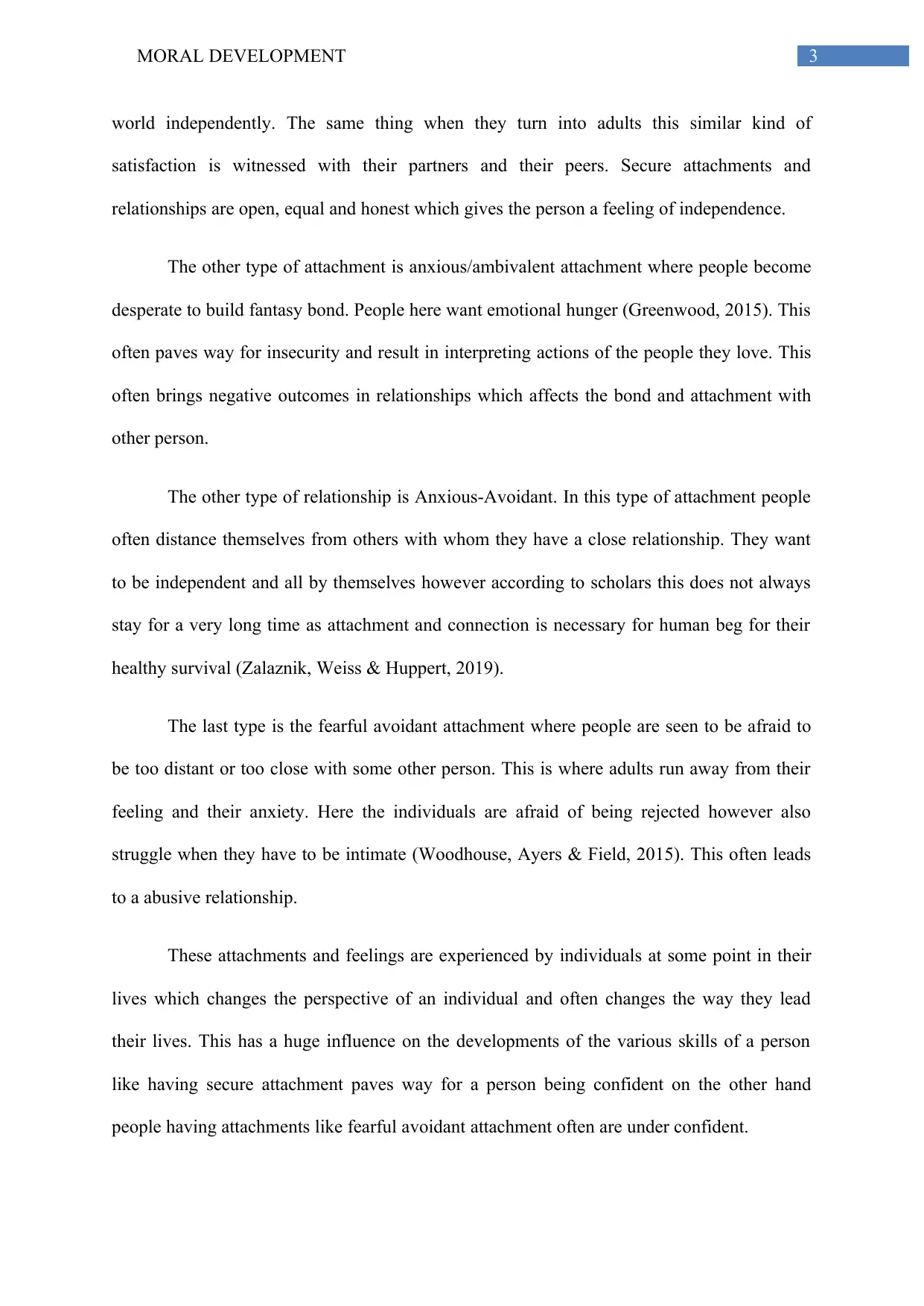
3MORAL DEVELOPMENT
world independently. The same thing when they turn into adults this similar kind of
satisfaction is witnessed with their partners and their peers. Secure attachments and
relationships are open, equal and honest which gives the person a feeling of independence.
The other type of attachment is anxious/ambivalent attachment where people become
desperate to build fantasy bond. People here want emotional hunger (Greenwood, 2015). This
often paves way for insecurity and result in interpreting actions of the people they love. This
often brings negative outcomes in relationships which affects the bond and attachment with
other person.
The other type of relationship is Anxious-Avoidant. In this type of attachment people
often distance themselves from others with whom they have a close relationship. They want
to be independent and all by themselves however according to scholars this does not always
stay for a very long time as attachment and connection is necessary for human beg for their
healthy survival (Zalaznik, Weiss & Huppert, 2019).
The last type is the fearful avoidant attachment where people are seen to be afraid to
be too distant or too close with some other person. This is where adults run away from their
feeling and their anxiety. Here the individuals are afraid of being rejected however also
struggle when they have to be intimate (Woodhouse, Ayers & Field, 2015). This often leads
to a abusive relationship.
These attachments and feelings are experienced by individuals at some point in their
lives which changes the perspective of an individual and often changes the way they lead
their lives. This has a huge influence on the developments of the various skills of a person
like having secure attachment paves way for a person being confident on the other hand
people having attachments like fearful avoidant attachment often are under confident.
world independently. The same thing when they turn into adults this similar kind of
satisfaction is witnessed with their partners and their peers. Secure attachments and
relationships are open, equal and honest which gives the person a feeling of independence.
The other type of attachment is anxious/ambivalent attachment where people become
desperate to build fantasy bond. People here want emotional hunger (Greenwood, 2015). This
often paves way for insecurity and result in interpreting actions of the people they love. This
often brings negative outcomes in relationships which affects the bond and attachment with
other person.
The other type of relationship is Anxious-Avoidant. In this type of attachment people
often distance themselves from others with whom they have a close relationship. They want
to be independent and all by themselves however according to scholars this does not always
stay for a very long time as attachment and connection is necessary for human beg for their
healthy survival (Zalaznik, Weiss & Huppert, 2019).
The last type is the fearful avoidant attachment where people are seen to be afraid to
be too distant or too close with some other person. This is where adults run away from their
feeling and their anxiety. Here the individuals are afraid of being rejected however also
struggle when they have to be intimate (Woodhouse, Ayers & Field, 2015). This often leads
to a abusive relationship.
These attachments and feelings are experienced by individuals at some point in their
lives which changes the perspective of an individual and often changes the way they lead
their lives. This has a huge influence on the developments of the various skills of a person
like having secure attachment paves way for a person being confident on the other hand
people having attachments like fearful avoidant attachment often are under confident.
Paraphrase This Document
Need a fresh take? Get an instant paraphrase of this document with our AI Paraphraser
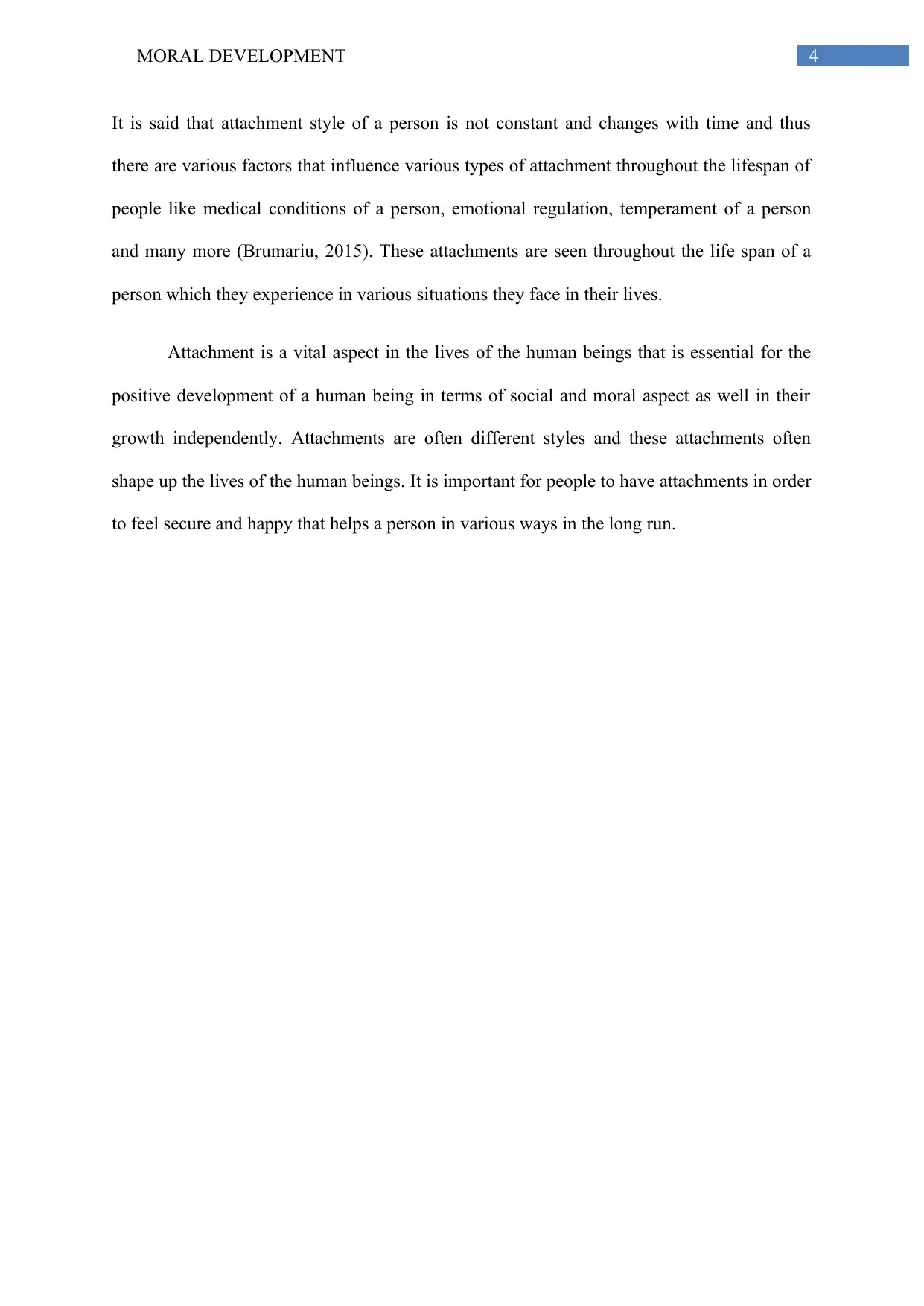
4MORAL DEVELOPMENT
It is said that attachment style of a person is not constant and changes with time and thus
there are various factors that influence various types of attachment throughout the lifespan of
people like medical conditions of a person, emotional regulation, temperament of a person
and many more (Brumariu, 2015). These attachments are seen throughout the life span of a
person which they experience in various situations they face in their lives.
Attachment is a vital aspect in the lives of the human beings that is essential for the
positive development of a human being in terms of social and moral aspect as well in their
growth independently. Attachments are often different styles and these attachments often
shape up the lives of the human beings. It is important for people to have attachments in order
to feel secure and happy that helps a person in various ways in the long run.
It is said that attachment style of a person is not constant and changes with time and thus
there are various factors that influence various types of attachment throughout the lifespan of
people like medical conditions of a person, emotional regulation, temperament of a person
and many more (Brumariu, 2015). These attachments are seen throughout the life span of a
person which they experience in various situations they face in their lives.
Attachment is a vital aspect in the lives of the human beings that is essential for the
positive development of a human being in terms of social and moral aspect as well in their
growth independently. Attachments are often different styles and these attachments often
shape up the lives of the human beings. It is important for people to have attachments in order
to feel secure and happy that helps a person in various ways in the long run.
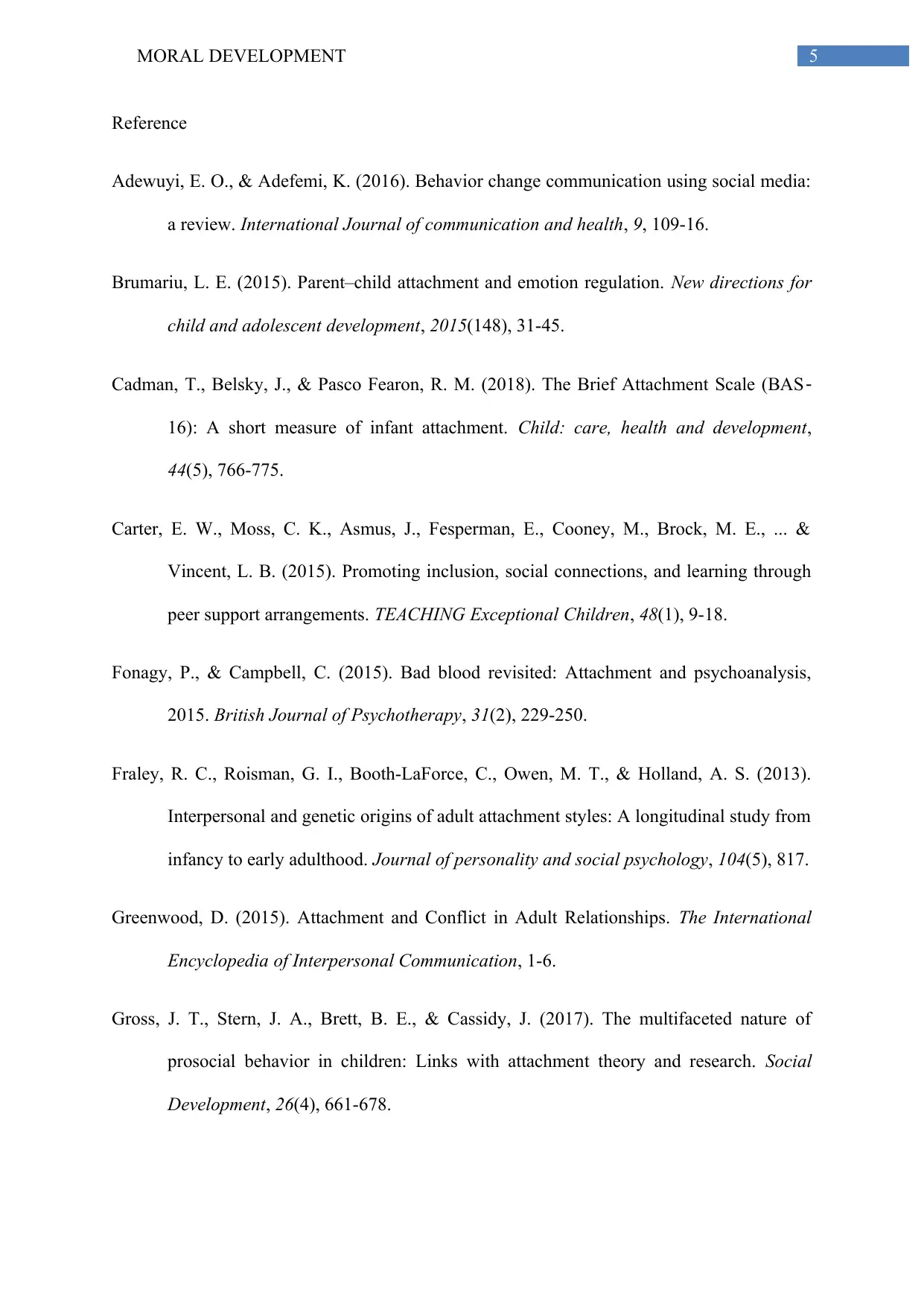
5MORAL DEVELOPMENT
Reference
Adewuyi, E. O., & Adefemi, K. (2016). Behavior change communication using social media:
a review. International Journal of communication and health, 9, 109-16.
Brumariu, L. E. (2015). Parent–child attachment and emotion regulation. New directions for
child and adolescent development, 2015(148), 31-45.
Cadman, T., Belsky, J., & Pasco Fearon, R. M. (2018). The Brief Attachment Scale (BAS‐
16): A short measure of infant attachment. Child: care, health and development,
44(5), 766-775.
Carter, E. W., Moss, C. K., Asmus, J., Fesperman, E., Cooney, M., Brock, M. E., ... &
Vincent, L. B. (2015). Promoting inclusion, social connections, and learning through
peer support arrangements. TEACHING Exceptional Children, 48(1), 9-18.
Fonagy, P., & Campbell, C. (2015). Bad blood revisited: Attachment and psychoanalysis,
2015. British Journal of Psychotherapy, 31(2), 229-250.
Fraley, R. C., Roisman, G. I., Booth-LaForce, C., Owen, M. T., & Holland, A. S. (2013).
Interpersonal and genetic origins of adult attachment styles: A longitudinal study from
infancy to early adulthood. Journal of personality and social psychology, 104(5), 817.
Greenwood, D. (2015). Attachment and Conflict in Adult Relationships. The International
Encyclopedia of Interpersonal Communication, 1-6.
Gross, J. T., Stern, J. A., Brett, B. E., & Cassidy, J. (2017). The multifaceted nature of
prosocial behavior in children: Links with attachment theory and research. Social
Development, 26(4), 661-678.
Reference
Adewuyi, E. O., & Adefemi, K. (2016). Behavior change communication using social media:
a review. International Journal of communication and health, 9, 109-16.
Brumariu, L. E. (2015). Parent–child attachment and emotion regulation. New directions for
child and adolescent development, 2015(148), 31-45.
Cadman, T., Belsky, J., & Pasco Fearon, R. M. (2018). The Brief Attachment Scale (BAS‐
16): A short measure of infant attachment. Child: care, health and development,
44(5), 766-775.
Carter, E. W., Moss, C. K., Asmus, J., Fesperman, E., Cooney, M., Brock, M. E., ... &
Vincent, L. B. (2015). Promoting inclusion, social connections, and learning through
peer support arrangements. TEACHING Exceptional Children, 48(1), 9-18.
Fonagy, P., & Campbell, C. (2015). Bad blood revisited: Attachment and psychoanalysis,
2015. British Journal of Psychotherapy, 31(2), 229-250.
Fraley, R. C., Roisman, G. I., Booth-LaForce, C., Owen, M. T., & Holland, A. S. (2013).
Interpersonal and genetic origins of adult attachment styles: A longitudinal study from
infancy to early adulthood. Journal of personality and social psychology, 104(5), 817.
Greenwood, D. (2015). Attachment and Conflict in Adult Relationships. The International
Encyclopedia of Interpersonal Communication, 1-6.
Gross, J. T., Stern, J. A., Brett, B. E., & Cassidy, J. (2017). The multifaceted nature of
prosocial behavior in children: Links with attachment theory and research. Social
Development, 26(4), 661-678.
⊘ This is a preview!⊘
Do you want full access?
Subscribe today to unlock all pages.

Trusted by 1+ million students worldwide
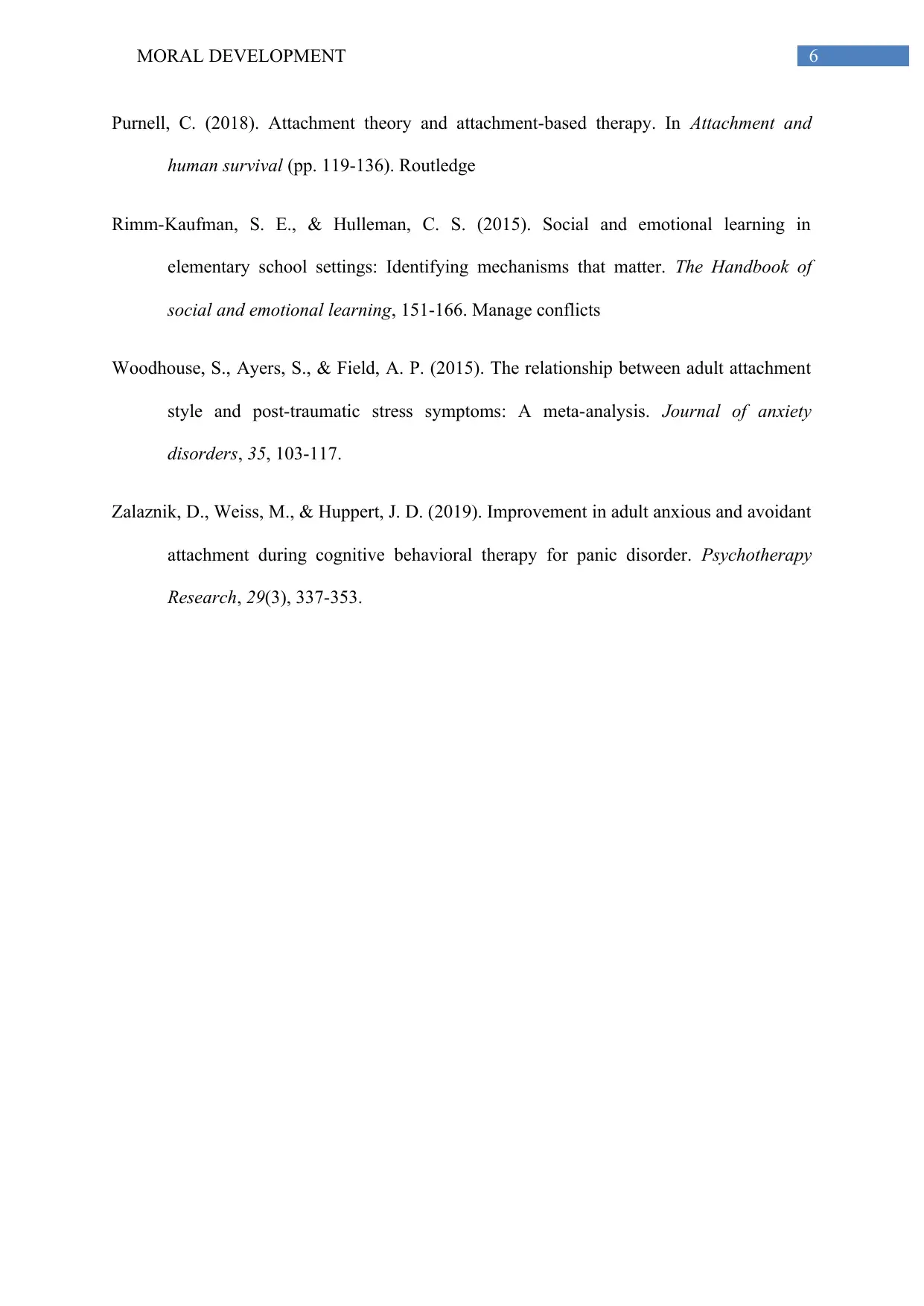
6MORAL DEVELOPMENT
Purnell, C. (2018). Attachment theory and attachment-based therapy. In Attachment and
human survival (pp. 119-136). Routledge
Rimm-Kaufman, S. E., & Hulleman, C. S. (2015). Social and emotional learning in
elementary school settings: Identifying mechanisms that matter. The Handbook of
social and emotional learning, 151-166. Manage conflicts
Woodhouse, S., Ayers, S., & Field, A. P. (2015). The relationship between adult attachment
style and post-traumatic stress symptoms: A meta-analysis. Journal of anxiety
disorders, 35, 103-117.
Zalaznik, D., Weiss, M., & Huppert, J. D. (2019). Improvement in adult anxious and avoidant
attachment during cognitive behavioral therapy for panic disorder. Psychotherapy
Research, 29(3), 337-353.
Purnell, C. (2018). Attachment theory and attachment-based therapy. In Attachment and
human survival (pp. 119-136). Routledge
Rimm-Kaufman, S. E., & Hulleman, C. S. (2015). Social and emotional learning in
elementary school settings: Identifying mechanisms that matter. The Handbook of
social and emotional learning, 151-166. Manage conflicts
Woodhouse, S., Ayers, S., & Field, A. P. (2015). The relationship between adult attachment
style and post-traumatic stress symptoms: A meta-analysis. Journal of anxiety
disorders, 35, 103-117.
Zalaznik, D., Weiss, M., & Huppert, J. D. (2019). Improvement in adult anxious and avoidant
attachment during cognitive behavioral therapy for panic disorder. Psychotherapy
Research, 29(3), 337-353.
1 out of 7
Related Documents
Your All-in-One AI-Powered Toolkit for Academic Success.
+13062052269
info@desklib.com
Available 24*7 on WhatsApp / Email
![[object Object]](/_next/static/media/star-bottom.7253800d.svg)
Unlock your academic potential
Copyright © 2020–2025 A2Z Services. All Rights Reserved. Developed and managed by ZUCOL.





